Transform your kitchen experience with these stress-free meal prep strategies. Start simple, create weekly plans, and prep ingredients ahead. Invest in time-saving tools and embrace one-pot meals for easy cleanup. Practice mindful cooking techniques to stay calm and focused. Keep your pantry organized to reduce decision fatigue. Cook in batches to maximize efficiency and variety. Build a support system by connecting with fellow cooks. Don't forget to utilize your slow cooker for hands-off meal preparation. By incorporating these techniques, you'll find meal prep less intimidating and more enjoyable. Discover how these strategies can revolutionize your approach to cooking.
Start With Simple Recipes
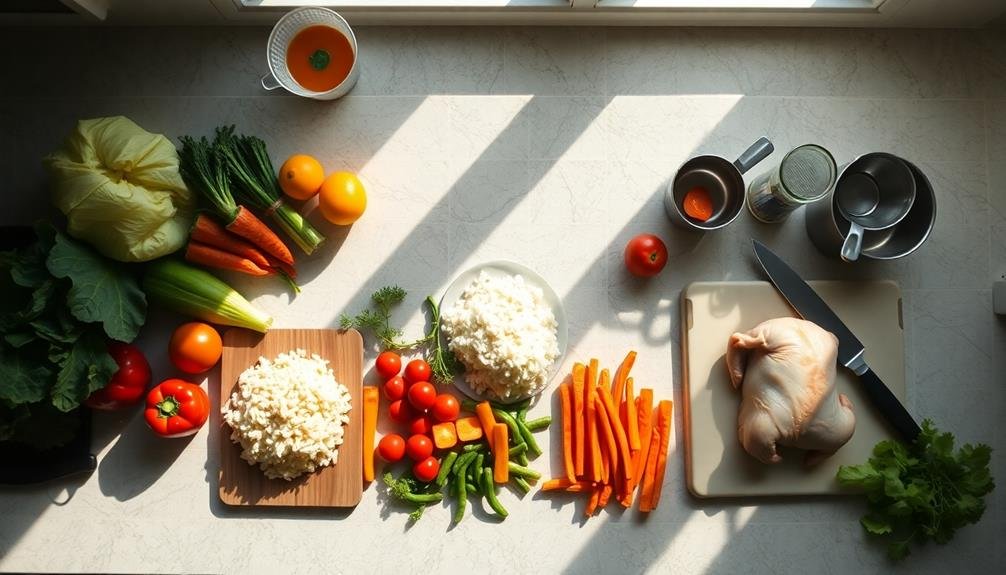
Often, the key to successful meal prep for anxious cooks lies in starting with simple recipes. Choose dishes with few ingredients and straightforward cooking methods. Look for one-pot meals, sheet pan dinners, or slow cooker recipes that require minimal hands-on time. These options reduce the stress of juggling multiple components and allow you to build confidence in the kitchen.
Begin with recipes that use familiar ingredients and techniques you're comfortable with. As you gain experience, gradually introduce new elements or cooking methods. Start by mastering a few versatile staples like roasted vegetables, basic grains, and simple proteins. These can be mixed and matched to create various meals throughout the week.
Don't be afraid to rely on convenience items like pre-cut vegetables or rotisserie chicken to simplify your meal prep process. Remember, it's okay to take shortcuts while you're building your cooking skills.
As you become more comfortable, you can experiment with making these items from scratch. By starting small and focusing on simplicity, you'll create a solid foundation for stress-free meal preparation.
Create a Weekly Meal Plan
Despite its initial challenges, creating a weekly meal plan can greatly reduce anxiety around cooking. By taking the guesswork out of daily meal decisions, you'll save time and mental energy throughout the week.
Start by choosing a specific day to plan your meals, like Sunday afternoon. List out the meals you'll prepare for each day, considering your schedule and any upcoming events.
When planning, aim for a mix of familiar recipes and new dishes to keep things interesting. Include a variety of proteins, vegetables, and grains to guarantee balanced nutrition.
Don't forget to account for leftovers, which can simplify lunch preparations. As you create your plan, make a corresponding grocery list to streamline your shopping trip.
Be flexible with your plan; it's okay to swap meals around if needed. Consider batch cooking certain ingredients, like grilled chicken or roasted vegetables, that can be used in multiple dishes throughout the week.
This approach saves time and reduces daily cooking stress. Remember to include some quick and easy meals for busier days.
With practice, meal planning will become a habit that considerably eases your cooking anxiety.
Prep Ingredients in Advance
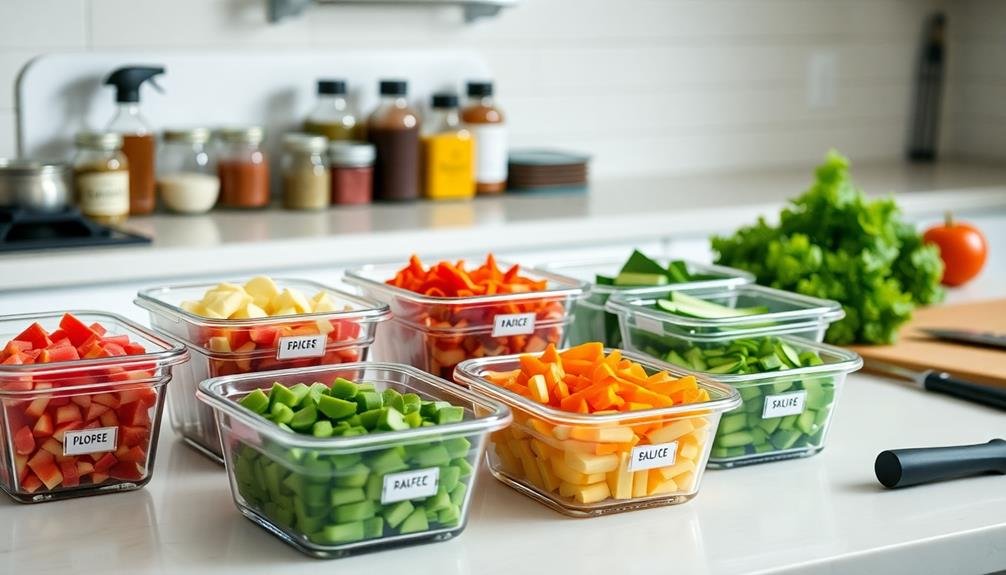
Prepping ingredients in advance can greatly reduce your cooking anxiety.
You'll save time and stress by washing and chopping vegetables, portioning proteins and grains, and pre-mixing spice blends before your busy week begins.
These simple steps transform overwhelming recipes into manageable tasks, making weeknight cooking a breeze.
Wash and Chop Veggies
One of the most effective ways to reduce cooking anxiety is to wash and chop your veggies in advance. Set aside time on weekends or less busy days to prepare your produce for the week ahead. This simple step can save you precious minutes and reduce stress during weeknight meal preparation.
Start by washing all your vegetables thoroughly. Then, chop them according to your planned recipes. Store prepped veggies in airtight containers or zip-top bags in the refrigerator. Here's a quick guide to help you get started:
| Vegetable | Prep Method | Storage Time |
|---|---|---|
| Carrots | Peel, slice | 3-4 days |
| Onions | Dice | 7-10 days |
| Bell Peppers | Slice | 2-3 days |
| Broccoli | Florets | 3-4 days |
| Lettuce | Tear, wash | 3-5 days |
Portion Proteins and Grains
A cook's anxiety can be greatly reduced by portioning proteins and grains in advance. By dedicating time to this task, you'll streamline your cooking process and minimize stress during meal preparation.
Start by measuring out individual portions of proteins like chicken, fish, or tofu, and store them in airtight containers or freezer bags. For grains, cook larger batches of rice, quinoa, or pasta, then divide them into portion-sized containers.
When portioning proteins and grains, consider these benefits:
- Saves time during busy weekdays
- Guarantees consistent portion sizes
- Reduces food waste
- Simplifies meal planning
- Facilitates quick and easy meal assembly
To make the process even more efficient, invest in a kitchen scale and a set of measuring cups. Label each container with the contents and date to keep track of freshness.
If you're freezing portioned proteins, consider using a vacuum sealer to prevent freezer burn and extend shelf life. By incorporating this step into your meal prep routine, you'll find that cooking becomes less intimidating and more manageable, allowing you to approach each meal with confidence and ease.
Pre-Mix Spice Blends
Another time-saving strategy for anxious cooks is to pre-mix spice blends. By creating your own custom spice mixes in advance, you'll streamline your cooking process and reduce the stress of measuring multiple spices for each recipe.
Start by identifying your most frequently used spice combinations and blend them in larger quantities. Store these mixes in airtight containers or small jars, labeling each with its contents and suggested uses.
Popular blends to take into account include taco seasoning, Italian herbs, curry powder, and all-purpose seasoning. You can also create specific blends for your favorite dishes, like a perfect pizza seasoning or a go-to rub for grilled meats.
When it's time to cook, you'll simply reach for one jar instead of juggling several, saving time and reducing kitchen clutter.
Pre-mixing spices not only simplifies your cooking routine but also allows you to control the ingredients and adjust flavors to your liking. You'll avoid unnecessary additives often found in store-bought mixes and can experiment with different ratios to perfect your blends.
This strategy empowers you to cook with confidence, knowing you've got perfectly balanced seasonings at your fingertips.
Invest in Time-Saving Kitchen Tools
Having the right tools can make a world of difference for anxious cooks tackling meal prep. Investing in time-saving kitchen gadgets can streamline your process and reduce stress. Consider purchasing a food processor for quick chopping and blending, or a slow cooker for hands-off meal preparation. An Instant Pot combines multiple functions, saving both time and counter space.
Don't overlook the importance of quality knives and cutting boards. Sharp knives make chopping faster and safer, while sturdy cutting boards provide a stable work surface. Meal prep containers are essential for portioning and storing your prepared meals.
Here are five must-have time-saving kitchen tools:
- Food processor
- Slow cooker or Instant Pot
- High-quality chef's knife
- Set of stackable meal prep containers
- Immersion blender
These tools will help you efficiently prep ingredients, cook meals, and store your creations.
Remember, you don't need to buy everything at once. Start with one or two items that address your biggest meal prep challenges, and gradually build your collection.
With the right tools at your disposal, you'll find meal prep less intimidating and more enjoyable.
Embrace One-Pot Meals
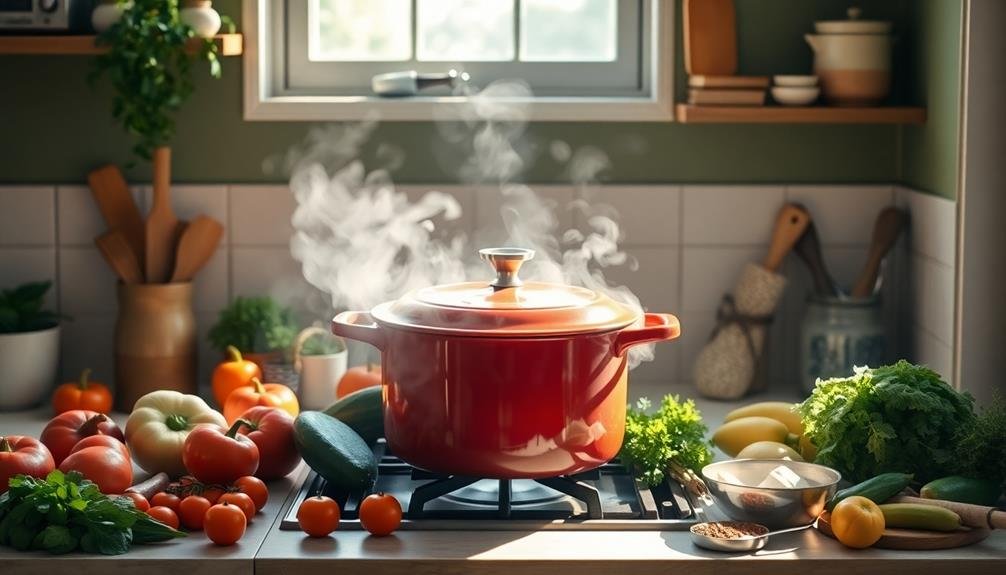
One-pot meals are your ticket to simplifying the cooking process and reducing anxiety in the kitchen.
You'll appreciate how these dishes minimize cleanup time, allowing you to focus more on enjoying your meal and less on washing multiple pots and pans.
From hearty stews to flavorful casseroles, one-pot recipes offer versatile options that can easily be adapted to your taste preferences and dietary needs.
Simplify Cooking Process
To simplify your meal prep routine, embrace the convenience of one-pot meals. These dishes require minimal cleanup and allow you to cook entire meals in a single pot or pan. Start by choosing recipes that combine protein, vegetables, and grains in one cooking vessel. Soups, stews, casseroles, and skillet dishes are excellent options for streamlined meal prep.
When selecting one-pot recipes, look for those with:
- Simple ingredient lists
- Minimal prep steps
- Hands-off cooking time
- Easy cleanup
- Versatile serving options
To further simplify your cooking process, prep ingredients in advance. Wash and chop vegetables, measure out spices, and portion proteins before you start cooking. This organization will help you feel more in control and reduce anxiety during meal preparation.
Invest in quality cookware that can shift from stovetop to oven, allowing you to start and finish dishes in the same pot. Slow cookers and pressure cookers are also valuable tools for creating effortless one-pot meals.
Minimize Cleanup Time
Streamlining your cooking process naturally leads to less cleanup time, a major benefit of one-pot meals. These dishes allow you to create delicious, complete meals using just one cooking vessel, greatly reducing the number of pots, pans, and utensils you'll need to wash afterward.
To embrace one-pot cooking, start by exploring recipes for stews, casseroles, and skillet meals. These dishes often combine proteins, vegetables, and grains in a single pot, creating a balanced meal with minimal fuss.
Invest in versatile cookware like a large Dutch oven or a deep skillet with a lid, which can handle various cooking methods from stovetop to oven.
When preparing one-pot meals, layer ingredients strategically to guarantee even cooking. Begin with aromatics like onions and garlic, then add proteins and longer-cooking vegetables.
Finish with quick-cooking items and any necessary liquids. This approach not only simplifies the cooking process but also intensifies flavors as ingredients meld together.
Versatile Recipe Options
Versatility is key when embracing one-pot meals for anxiety-friendly meal prep. These dishes offer endless possibilities, allowing you to create diverse meals without overwhelming yourself with complex recipes or multiple cooking steps.
One-pot meals are perfect for batch cooking, ensuring you'll have nutritious options throughout the week.
Choose recipes that can be easily modified to suit your preferences or dietary needs. Soups, stews, and casseroles are excellent starting points. You can swap ingredients, adjust spices, or add different proteins to create new variations each time. This flexibility helps prevent meal fatigue and keeps your taste buds excited.
Consider these versatile one-pot meal ideas:
- Chili (vegetarian, beef, or turkey)
- Risotto (with various vegetables or proteins)
- Curry (chicken, vegetable, or seafood)
- Pasta dishes (countless sauce and add-in options)
- Grain bowls (mix and match grains, veggies, and proteins)
Utilize Slow Cooker Recipes
Slow cookers are an anxious cook's best friend. They allow you to simply toss ingredients in, set the timer, and forget about it until mealtime. This hands-off approach can greatly reduce cooking-related stress and anxiety.
To maximize your slow cooker's potential, start by collecting a variety of easy recipes. Look for one-pot meals that require minimal prep work, such as chili, stews, and soups. These dishes often improve with longer cooking times, making them perfect for slow cookers.
When meal prepping with a slow cooker, consider making large batches that you can portion and freeze for later use. This strategy guarantees you'll have ready-made meals on hand for busy or high-anxiety days. You can also prep ingredients for multiple slow cooker meals at once, storing them in freezer bags for easy dump-and-go cooking later.
Don't limit yourself to main dishes; slow cookers are great for sides, desserts, and even breakfast items. Overnight oatmeal, for example, can provide a stress-free start to your day.
Practice Mindful Cooking Techniques
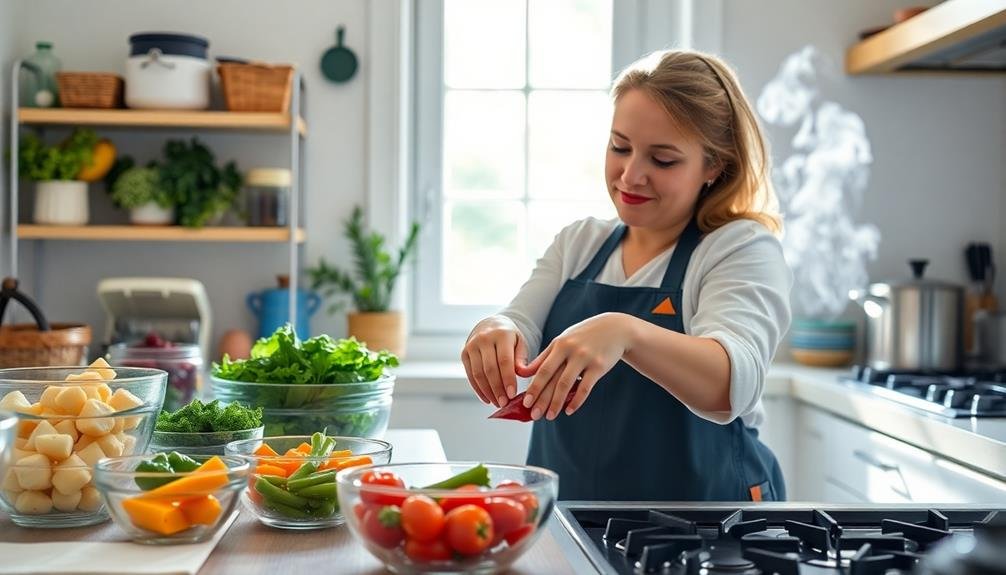
Practicing mindfulness while cooking can greatly reduce your anxiety in the kitchen.
Try incorporating deep breathing exercises as you chop vegetables or stir a pot, allowing yourself to focus on the present moment.
Pay close attention to the sensory experiences of cooking, such as the aroma of spices, the sizzle of ingredients in the pan, or the texture of foods as you prepare them.
Deep Breathing While Cooking
Anxiety can turn the kitchen into a battleground, but deep breathing while cooking is a powerful tool to reclaim your culinary calm. As you prepare meals, incorporate deep breathing exercises to center yourself and reduce stress.
Start by taking slow, deliberate breaths, focusing on the inhale and exhale. This simple act can lower your heart rate and relax tense muscles, allowing you to approach cooking with a clearer mind.
To practice deep breathing while cooking, try these techniques:
- Count your breaths: Inhale for four counts, hold for four, exhale for four
- Use kitchen timers as breathing cues
- Sync your breath with repetitive tasks like chopping or stirring
- Pause and take three deep breaths before starting each new recipe step
- Visualize tension leaving your body with each exhale
Focus on Sensory Experiences
In spite of anxiety's grip, focusing on sensory experiences can transform cooking into a grounding practice. Engage your senses fully as you prepare meals, allowing each sensation to anchor you in the present moment.
Start by noticing the vibrant colors of fresh produce or the gleam of stainless steel utensils. Feel the textures of ingredients as you chop, slice, or knead, paying attention to their unique qualities.
Listen to the sizzle of vegetables hitting a hot pan or the gentle bubbling of a simmering sauce. Inhale deeply, savoring the aromas that waft through your kitchen. As you taste your creations, focus on the interplay of flavors and textures on your palate. This mindful approach not only reduces anxiety but also enhances your culinary skills.
To further cultivate mindfulness, try cooking without distractions like TV or music. Instead, tune into the rhythmic sounds of your knife on the cutting board or the whir of your blender.
Organize Your Pantry
Three key steps can transform your pantry into an anxiety-reducing meal prep hub. First, declutter and remove expired items. This creates space and eliminates decision fatigue.
Second, group similar items together, making ingredients easier to locate.
Finally, invest in clear storage containers to keep dry goods fresh and visible.
When organizing, consider creating zones based on meal types or cooking methods. For instance, designate areas for:
- Breakfast items
- Baking supplies
- Quick meal ingredients
- Snacks
- Canned goods
Label everything clearly, including expiration dates. This simple step can greatly reduce stress when planning meals or restocking supplies.
Maintain your organized pantry by implementing a "first in, first out" system. Place newer items behind older ones to guarantee you use ingredients before they expire.
Regularly audit your pantry, perhaps monthly, to stay on top of what you have and what you need.
An organized pantry not only saves time but also inspires creativity in your cooking. You'll be more likely to try new recipes when you can easily see and access your ingredients, turning meal prep from a source of anxiety into an enjoyable experience.
Cook in Batches
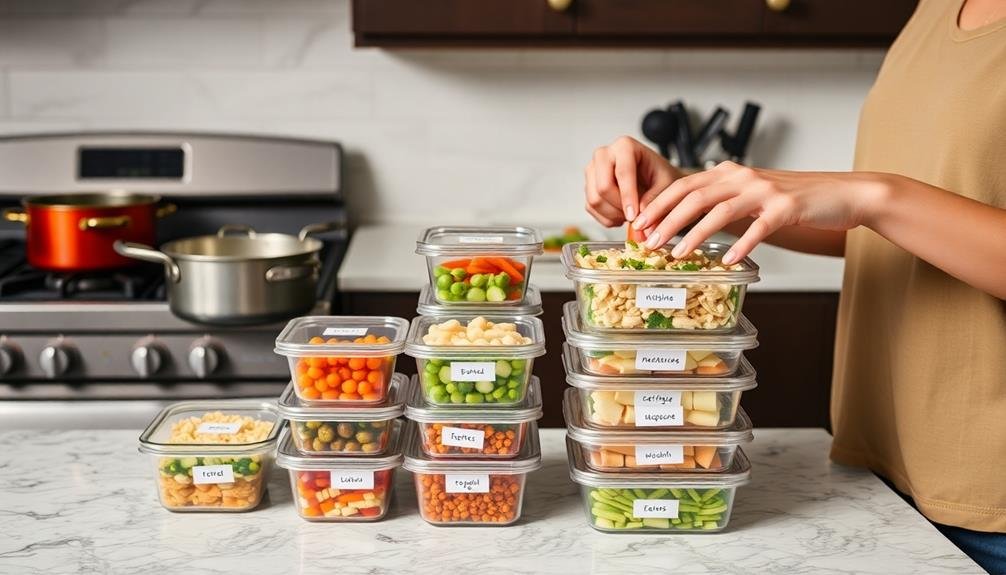
With your pantry organized, you're ready to tackle one of the most efficient meal prep strategies: batch cooking. This approach involves preparing larger quantities of food at once, saving you time and energy throughout the week. Start by selecting recipes that scale well and freeze easily, such as soups, stews, casseroles, or grain bowls.
Choose a day when you have a few hours to dedicate to cooking. Begin with dishes that require the longest cooking times, like slow-cooked meats or roasted vegetables. While these are cooking, prepare other components like grains, sauces, or chopped vegetables. Use your oven, stovetop, and slow cooker simultaneously to maximize efficiency.
Once cooked, portion your meals into individual containers for easy grab-and-go lunches or quick dinners. Label each container with the contents and date to keep track of freshness. Store meals in the refrigerator for up to four days or in the freezer for longer-term storage.
Don't forget to prep ingredients for future use. Chop extra vegetables, cook additional grains, or prepare protein sources like grilled chicken or hard-boiled eggs. These components can be mixed and matched for quick meals throughout the week.
Build a Support System
Along with developing practical cooking skills, building a support system is essential for anxious cooks. Reach out to friends, family, or online communities who share your interest in cooking. You'll find encouragement, tips, and reassurance from others who understand your challenges.
Consider joining a cooking class or group where you can learn alongside others. This shared experience can boost your confidence and provide a network of fellow learners. Don't hesitate to ask for help when needed, whether it's assistance with meal planning or someone to cook with you occasionally.
Create a supportive environment at home by:
- Involving family members in meal prep
- Sharing cooking responsibilities with a partner
- Hosting potluck dinners with friends
- Joining online forums or social media groups for anxious cooks
- Finding a cooking buddy for accountability and motivation
Frequently Asked Questions
How Do I Handle Unexpected Guests During Meal Prep?
When unexpected guests arrive during meal prep, don't panic. Quickly assess what you have on hand. You can stretch your meal by adding a simple side dish or appetizer. Involve your guests in the process for a fun, relaxed atmosphere.
What Are Some Strategies for Dealing With Food Allergies While Meal Prepping?
When dealing with food allergies during meal prep, you'll want to carefully read labels, avoid cross-contamination, and keep allergen-free alternatives on hand. It's also smart to plan versatile meals that can be easily modified for various dietary needs.
How Can I Incorporate More Variety Into My Meal Prep Routine?
You can add variety to your meal prep by exploring new recipes, experimenting with different cuisines, and using seasonal ingredients. Try swapping proteins, grains, or veggies in your usual dishes. Don't be afraid to mix things up!
What's the Best Way to Store Prepped Meals for Maximum Freshness?
You'll want to use airtight containers and store meals in the fridge or freezer. Label and date everything. For maximum freshness, consume refrigerated meals within 3-4 days and frozen meals within 2-3 months. Don't overfill containers.
How Do I Stay Motivated When Meal Prepping Becomes Monotonous?
You can stay motivated by experimenting with new recipes, flavors, and cuisines. Try themed prep days, invite friends for a group session, or reward yourself after completing your prep. Mix things up to keep it exciting and enjoyable.
In Summary
You've now got a toolkit of strategies to make meal prep less intimidating. Remember, it's okay to start small and build your confidence over time. Don't be afraid to experiment and find what works best for you. With practice, you'll develop a rhythm that makes cooking feel more manageable and even enjoyable. Embrace the process, celebrate your successes, and be kind to yourself as you navigate your culinary journey. You've got this!

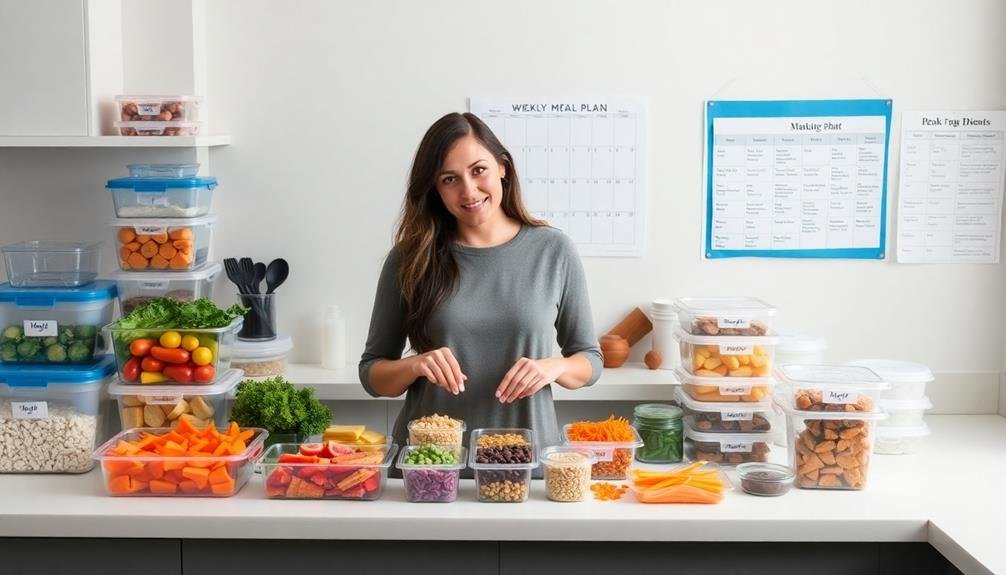



Leave a Reply